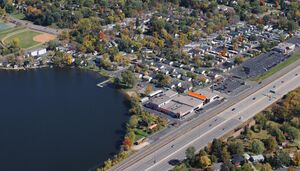
Difference between revisions of "Aaron test MS4 page"
| (3 intermediate revisions by the same user not shown) | |||
| Line 46: | Line 46: | ||
The municipal separate storm sewer system (MS4) stormwater program is designed to reduce the amount of <span title="any particulate matter that can be transported by fluid flow and which eventually is deposited as a layer of solid particles on the bed or bottom of a body of water"> '''sediment'''</span> and pollution that enters surface and ground water from storm sewer systems. Public entities that own or operate an MS4 play a key role in preventing or reducing the negative impacts stormwater <span title="the portion of rainfall or snowmelt not immediately absorbed into the soil that drains or flows off the land and becomes surface flow"> '''runoff'''</span> has on our valuable water resources. | The municipal separate storm sewer system (MS4) stormwater program is designed to reduce the amount of <span title="any particulate matter that can be transported by fluid flow and which eventually is deposited as a layer of solid particles on the bed or bottom of a body of water"> '''sediment'''</span> and pollution that enters surface and ground water from storm sewer systems. Public entities that own or operate an MS4 play a key role in preventing or reducing the negative impacts stormwater <span title="the portion of rainfall or snowmelt not immediately absorbed into the soil that drains or flows off the land and becomes surface flow"> '''runoff'''</span> has on our valuable water resources. | ||
| − | Proper stormwater runoff management in urbanized areas is especially important for restoring and protecting surface waters. Urbanized areas are more likely to have activities that contribute pollutants to stormwater runoff, like applying anti/deicing mixtures to roads; fueling vehicles; grease, oil, and other spills; landscaping; and using pesticides and fertilizers. Urbanized areas have a large amount of impervious surfaces, or surfaces that rain and snowmelt cannot pass through, such as streets, driveways, rooftops, parking lots and sidewalks. Stormwater runoff from these surfaces travels faster and in higher amounts, damaging rivers, streams, and wetlands; destroying aquatic habitats; increasing the amount of pollutants that enter surface waters; and limiting groundwater recharge. | + | Proper stormwater runoff management in urbanized areas is especially important for restoring and protecting surface waters. Urbanized areas are more likely to have activities that contribute pollutants to stormwater runoff, like applying anti/deicing mixtures to roads; fueling vehicles; grease, oil, and other spills; landscaping; and using pesticides and fertilizers. Urbanized areas have a large amount of impervious surfaces, or surfaces that rain and snowmelt cannot pass through, such as streets, driveways, rooftops, parking lots and sidewalks. Stormwater runoff from these surfaces travels faster and in higher amounts, damaging rivers, streams, and wetlands; destroying aquatic habitats; increasing the amount of pollutants that enter surface waters; and limiting groundwater recharge and the MS4 program is to help mitigate the impact. |
<!-- | <!-- | ||
| Line 91: | Line 91: | ||
<br> | <br> | ||
==Background Information== | ==Background Information== | ||
| − | *[[What is a municipal separate storm sewer system (MS4)?]] - REMOVED CITY OF AUSTIN IMAGE AND LINK ON THE RIGHT, NO LONGER AVAILABLE, ALREADY MOVED YOUTUBE VIDEO | + | *[[What is a municipal separate storm sewer system (MS4)?]] - REMOVED CITY OF AUSTIN IMAGE AND LINK ON THE RIGHT, NO LONGER AVAILABLE, ALREADY MOVED YOUTUBE VIDEO FROM THIS PAGE'S OTHER RESOURCES |
*[[Why is a municipality regulated under the MS4 permit?]] - DELETE OTHER RESOURCES | *[[Why is a municipality regulated under the MS4 permit?]] - DELETE OTHER RESOURCES | ||
<br> | <br> | ||
| Line 140: | Line 140: | ||
==MS4 audit guidance== | ==MS4 audit guidance== | ||
The U.S. Environmental Protection Agency (EPA) mandates the Minnesota Pollution Control Agency (MPCA) to evaluate MS4 permittees for compliance with the [https://www.pca.state.mn.us/sites/default/files/wq-strm4-59k.pdf MS4 General Permit]. The MPCA does this through compliance audits. To find out more information about the audit process see the pages below: | The U.S. Environmental Protection Agency (EPA) mandates the Minnesota Pollution Control Agency (MPCA) to evaluate MS4 permittees for compliance with the [https://www.pca.state.mn.us/sites/default/files/wq-strm4-59k.pdf MS4 General Permit]. The MPCA does this through compliance audits. To find out more information about the audit process see the pages below: | ||
| − | *[https://stormwater.pca.state.mn.us/index.php?title=General_Stormwater_Program_Management General Stormwater Program Management - Examples for tracking activities in your SWPPP] | + | *[https://stormwater.pca.state.mn.us/index.php?title=General_Stormwater_Program_Management General Stormwater Program Management - Examples for tracking activities in your SWPPP] - I FEEL THIS COULD BE PUT ON THE MAIN PAGE AND DELETED |
*[https://stormwater.pca.state.mn.us/index.php?title=Phase_II_MS4_audit_process Phase II MS4 Audit Process] | *[https://stormwater.pca.state.mn.us/index.php?title=Phase_II_MS4_audit_process Phase II MS4 Audit Process] | ||
*[https://stormwater.pca.state.mn.us/index.php?title=Self-audit_guidance_for_Phase_II_MS4s Self-Audit Guidance for Phase II MS4s] | *[https://stormwater.pca.state.mn.us/index.php?title=Self-audit_guidance_for_Phase_II_MS4s Self-Audit Guidance for Phase II MS4s] | ||
Revision as of 19:07, 2 May 2024
The municipal separate storm sewer system (MS4) stormwater program is designed to reduce the amount of sediment and pollution that enters surface and ground water from storm sewer systems. Public entities that own or operate an MS4 play a key role in preventing or reducing the negative impacts stormwater runoff has on our valuable water resources.
Proper stormwater runoff management in urbanized areas is especially important for restoring and protecting surface waters. Urbanized areas are more likely to have activities that contribute pollutants to stormwater runoff, like applying anti/deicing mixtures to roads; fueling vehicles; grease, oil, and other spills; landscaping; and using pesticides and fertilizers. Urbanized areas have a large amount of impervious surfaces, or surfaces that rain and snowmelt cannot pass through, such as streets, driveways, rooftops, parking lots and sidewalks. Stormwater runoff from these surfaces travels faster and in higher amounts, damaging rivers, streams, and wetlands; destroying aquatic habitats; increasing the amount of pollutants that enter surface waters; and limiting groundwater recharge and the MS4 program is to help mitigate the impact.
Contents
Background Information
- What is a municipal separate storm sewer system (MS4)? - REMOVED CITY OF AUSTIN IMAGE AND LINK ON THE RIGHT, NO LONGER AVAILABLE, ALREADY MOVED YOUTUBE VIDEO FROM THIS PAGE'S OTHER RESOURCES
- Why is a municipality regulated under the MS4 permit? - DELETE OTHER RESOURCES
2020 MS4 General Permit
- 2020 MS4 General Permit PDF Version
- 2020 MS4 General Permit Reissuance Page
- 2020 MS4 General Permit Wiki Version
MS4 stormwater permit
Previous permits
Minimum Control Measures
When seeking to manage a Municipal Storm Sewer System (MS4), an effective Stormwater Pollution Prevention Program (SWPPP) has six different components known as Minimum Control Measures (MCMs).
- Minimum Control Measures 1 - Public Education and Outreach - PAGE NEEDS TRANSFERRANCE
- Minimum Control Measures 2 - Public Participation/Involvement - PAGE NEEDS TRANSFERRANCE
- Minimum Control Measures 3 - Illicit Discharge Detection and Elimination - PAGE NEEDS TRANSFERRANCE
- Minimum Control Measures 4 - Construction Site Stormwater Control - PAGE NEEDS TRANSFERRANCE
- Minimum Control Measures 5 - Post-Construction Stormwater Management - PAGE NEEDS TRANSFERRANCE
- Minimum Control Measures 6 - Pollution Prevention/Good Housekeeping - PAGE NEEDS TRANSFERRANCE
Total Maximum Daily Loads (TMDLs)
Total Maximum Daily Loads (TMDLs) are EPA approved amounts of pollutant loading that can occur and have a water body meet water quality standards. Follow this link to learn more about them along with guidance and resources.
Tools and resources
- Assessing Total Suspended Sediment and Total Phosphorus Removal Efficiency of Permittee Owned/Operated Constructed Stormwater Ponds: guidance related to assessing the total suspended sediment (TSS) and total phosphorus (TP) removal efficiency of MS4 (Municipal Separate Storm Sewer System) permittee owned/operated ponds constructed and used for the collection and treatment of stormwater.
- Checklist Documents and Examples of Procedures - PAGE NEEDS TRANSFERRANCE
- Documentation Requirements and Documents to Retain Under the MS4 Permit - FIXED TABLE ALIGNMENT
- MS4 Mapping Tool: An interactive online map tool that can be used to view and explore Minnesota MS4 boundaries, defined urbanized areas, impaired waters, outstanding resource value waters, trout waters and approved TMDL study areas.
- New Permit Requirements and Related Guidance Materials
- Pollution Prevention Guidance Fact Sheets: A Collection of Links to a Variety of Minnesota Stormwater Manual Fact Sheets on Stormwater Pollution Prevention Methods Within MS4s.
MS4 audit guidance
The U.S. Environmental Protection Agency (EPA) mandates the Minnesota Pollution Control Agency (MPCA) to evaluate MS4 permittees for compliance with the MS4 General Permit. The MPCA does this through compliance audits. To find out more information about the audit process see the pages below:
- General Stormwater Program Management - Examples for tracking activities in your SWPPP - I FEEL THIS COULD BE PUT ON THE MAIN PAGE AND DELETED
- Phase II MS4 Audit Process
- Self-Audit Guidance for Phase II MS4s
MPCA MS4 technical assistance
- 2017 MS4 Technical Assistance and Outreach Needs Survey Results
- MS4 Case Studies
- MS4 Webinars and Videos
- MPCA MS4 Staff Contact Information
- MPCA MS4 Website
Other resources and documents
- Acknowledgements to Contributors - PAGE NEEDS TRANSFERRANCE
- MS4 Outreach Photo Library - PAGE NEEDS TRANSFERRANCE
- MS4 Program Overview and Minimum Control Measures (MCM) Descriptions - YouTube Video
- Pond, Lake, and Wetland Inventory
- Stormwater and Wetlands - Planning and Evaluation Guidelines
- Untreated Stormwater Runoff to Lakes, Streams, and Wetlands

